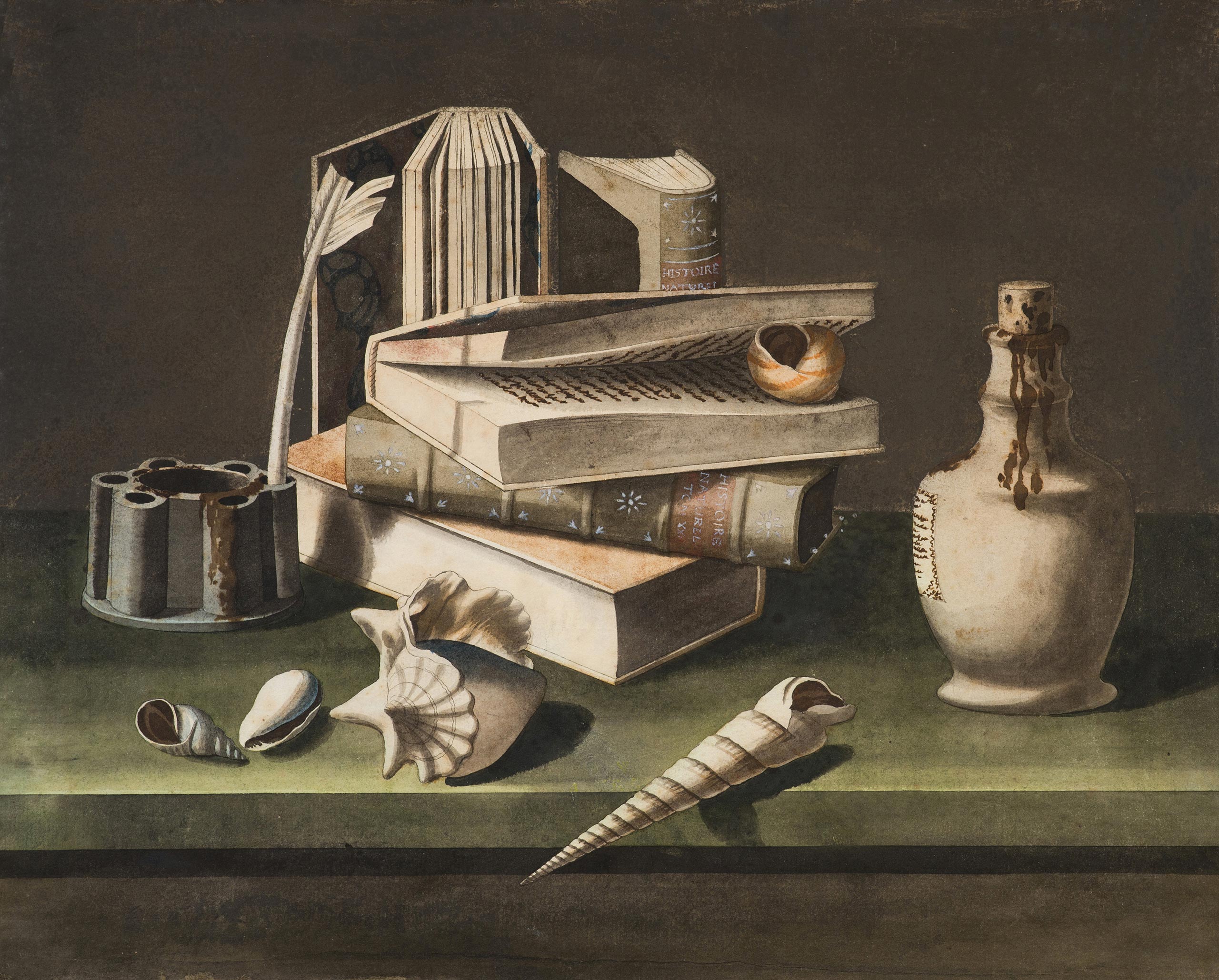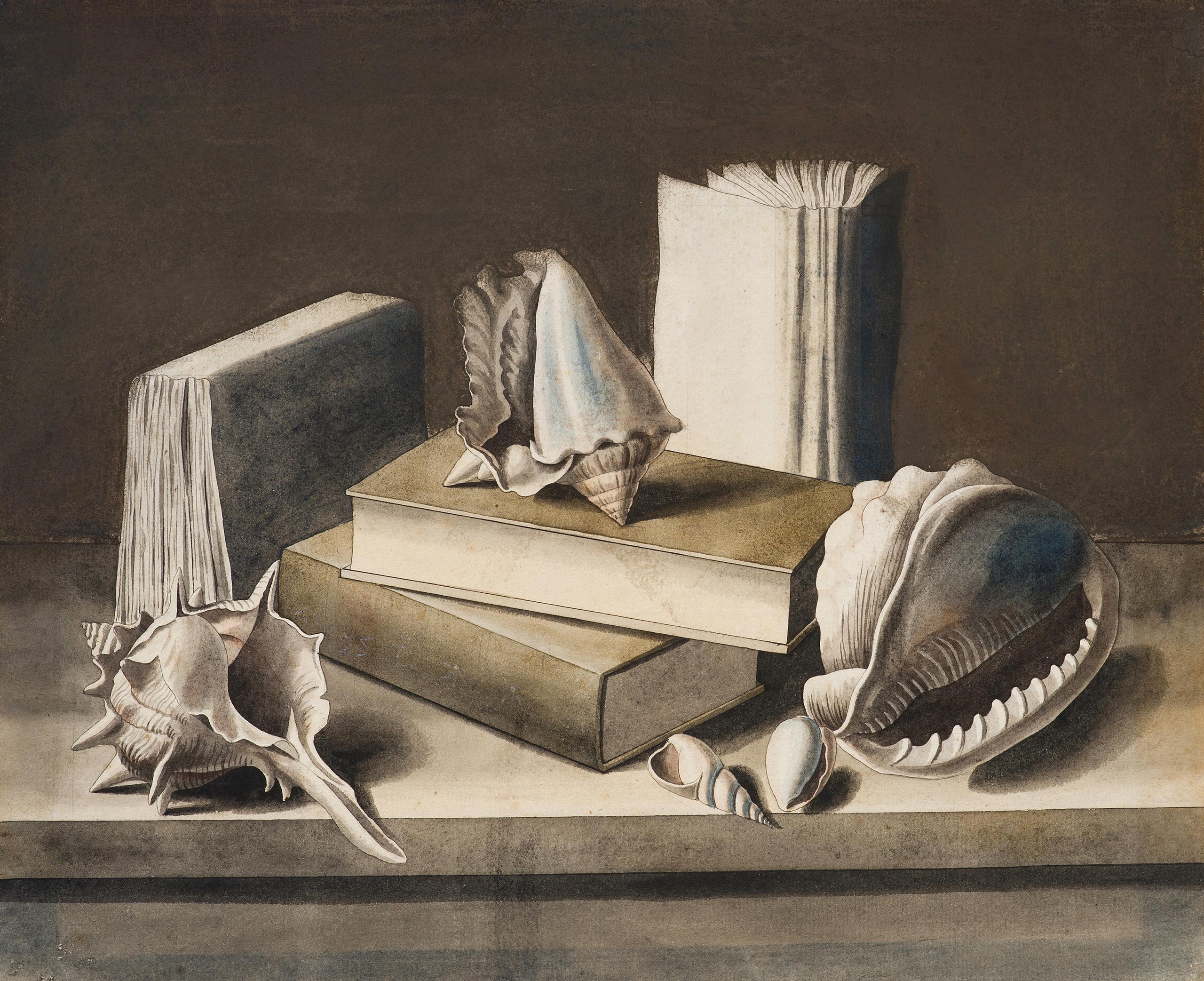
Bärens
Magdalene Margrethe
Copenhagen 1737 — 1808
Still Life with Books, Inkwell and Ink Bottle,
Shells and Snail Shell ;
Still life with Books and Shells (a pair)
Gouache, pen and watercolour.
400 x 330 mm (15 3⁄4 x 13 in.) each.
Danish artist and flower painter, Magdalene Margarethe Bärens was born in Copenhagen to Elisabeth Hochkirk and Johann Hermann Schäffer, master of the royal stables. A draughtsman himself and, by virtue of his position, highly skilled in equine anatomy, Schäffer helped the sculptor Jacques Saly to create his equestrian statue of King Ferdinand V. Magdalene showed a precocious gift for drawing that was probably nurtured through her father’s association with the French sculptor, and which her father encouraged unreservedly. Her mother, however, took a dim view of this artistic inclination and tried to restrict Magdalene’s education to learning how to run a household. Magdalene drew and painted secretly, teaching herself and developing an embroidery technique for copying engravings and ingeniously modelling fruit and flowers into sculptures made from rags and bran.
After marrying Johan Georg Bärens in 1761, she gave birth to four children and devoted herself to her family. She resumed her artistic activity at the age of forty, encouraged by the Danish painter Vigilius Eriksne, portrait artist to Catherine II of Russia. Her gouache paintings were exhibited at the Academy by her friends and teachers, and in 1780 she became the first woman to be admitted to the Royal Danish Academy of Fine Arts.
Appointed official flower painter to Queen Dowager Juliana Maria, who bought two paintings from her, Magdalene set up her studio in a greenhouse in order to paint flowers in all seasons. In 1783, she sent two paintings to Catherine II and received a gold medal in return. Between 1788 and 1790, she visited England with her husband, exhibited alongside Angelica Kaufmann and enjoyed a certain success, but came up against customs protectionism against foreign art, as well as competition from the English painter Mary Moser, who was well established in the art world and a member of the Royal Academy from its outset. Despite her great talent, Magdalene’s name disappeared in favour of another flower painter, Johan Laurentz Jensen (1800–1856), who became known as ’the father of Danish flower painting’. Her portrait is known to us from a work painted by Christian August Lorentzen in 1786.
Very few of Magdalene’s works come up for sale and the drawings attributed to her are done so by comparison with a drawing signed and dated ’1805’ in her own hand. All of them show objects assembled on a fine entablature in simple, spare compositions and sober colours. The outlines are drawn in black ink, visible and filled in with watercolour. Playing with contrasts of light and shadow and with the volumes of the objects and their slightly strange arrangements, Magdalene creates surprisingly modern compositions born of her lack of academic training, but profound and meditative, reflecting a character that is both contemplative and ingenious.
In these two almost monochrome works, exceptionally, there are no flowers or fruit, although volumes of Pliny’s Natural History are present to remind us of Magdalene’s central focus. She assembles books, bottles and shells on the traditional entablature, and focuses on the marbled effects of the inner binding; the leather, the blue reflections of the mother-of-pearl and the shadow of the feather on the pages of the half-open book. The assemblies of small objects (in this case shells) are characteristic of her work and can be found on several of Magdalene’s paintings documented in the photographic collection of Danish visual art at the Des KGL Bibliotek (Royal Danish Library).
Magdalene Margarethe Bärens was the very symbol of the female artist under the old regime: with no real artistic education, but naturally gifted and hard-working, she learned on her own, drawing on her observations of nature and experimenting with various techniques. Her technical weaknesses were compensated for by good taste, a grasp of composition and the deep spirit that emanated from all her works.


